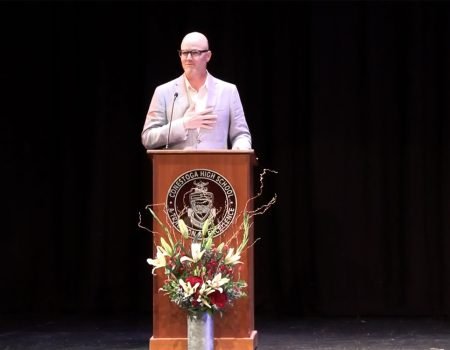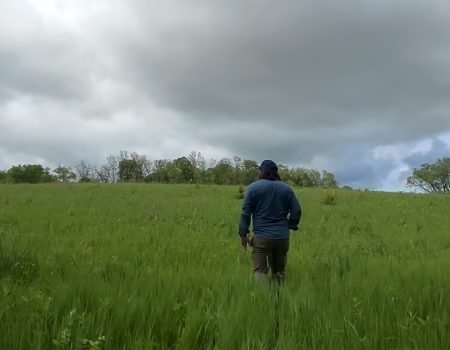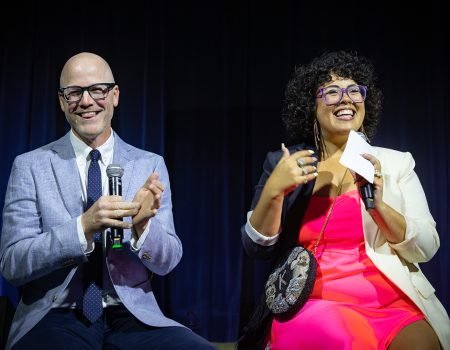Under The Red, White & Blue
In my younger and more vulnerable years, I often walked home along Ninth Avenue. I lived just east of Tenth then. The extra few steps mattered.
Though real estate agents will tell you otherwise, the neighborhood between 34th and 57th Streets west of Eight Avenue has long been referred to as Hell’s Kitchen. This, it struck me when moving here in 1994, bode well for my bio. Iowa kid in Hell’s Kitchen? There’s a contrast.
Most trace the origin of the Hell’s Kitchen moniker to the apocryphal story of Dutch Fred The Cop. The veteran policeman was supposed to have been watching a small riot on West 39th Street near Tenth Avenue. His rookie turned to him and said, “This place is hell itself.”
“Hell’s a mild climate,” Fred replied. “This is Hell’s Kitchen.”
Neighborhoods — like lives — change. Hell’s Kitchen has undergone radical transformation even since Chris and I first moved into our $1200/month railroad on 56th between Ninth & Tenth. Where, for example, a few rough and tumble bars once stood alongside brownstone tenaments, dozens of chic watering holes and swank eateries with names like Zanzibar, Latitudes, Whymm, and Eaterie have sprung up beneath the shadow of great, generic steel and glass towers with names like Archstone, The Biltmore, and The Westport.
Despite developers best efforts, though, there is some authenticity left on Tenth. Squint a little bit, and it might as well be 1937. And so I spend my new communte like a tourist, relishing each footfall like its my first.
Walking home after our first full day covering the increasingly bizarre Virginia Tech story for MTV News Monday night, I looked up to see the dense, billowing storm clouds part for an instant to reveal a sliver of sunset against clear, blue skies. Just below, glowing red like a beacon, I spotted a five red squares cut like a cross into a low-rise, brick edifice. Despite the death toll, and for just a moment, I felt lighter. For just an instant, I felt hopeful.
On Tuesday, of course, the story shifted radically. That Cho Seung-Hui had inexplicably paused between killings to shoot and encode video, photos, and a “manifesto,” then drop the package in the mail was almost inconceivable. That the media gobbled it up, well, wasn’t.
Lately, I’ve been passing my fourteen block, 1.03 mile, thirty-two minute round-trip communte listening to Public Radio International’s Studio 360. This week, host Kurt Anderson explores “The Great Gatsby.”
Just weeks prior to publication of his great american novel, it ends up, F Scott Fitzgerald drafted a frantic telegram to his editor, Maxwell Perkins. “Is it too late to change title?” he asked. Fitzgerald, it ends up, wanted to call the novel “Under The Red, White & Blue.” Cooler heads prevailed.
I went out of my way to pass that building again this morning. It is, I’ve come to learn, The Red Cross’ new New York City headquarters. As I passed, Anderson happened to be reading the closing passages of Fitzgerald’s defining work:
His dream must have seemed so close that he had hardly failed to grasp it. He did not know that it was already behind him, somewhere back in that vast obscurity beyond the city, where the dark field of the republic roll on under the night.”
Gatsby believed in the green light, the orgastic future that, year by year, recedes before us. It eluded us then, but that’s no matter tomorrow. We will run faster, stretch our arms farther. And one fine morning…
So we beat on, boats against the current, born back ceaselessly into the past.
I’m not sure what it all means, exactly, or how it all connects. But walking to work this morning, somehow, it did. Maybe it’s like the song says: “We all wanna’ be big stars, but we don’t know why, and we don’t know how.” Maybe it’s more of a “Bowling For Columbine” thing. Or maybe Bo is right: our children are the angriest, most violent children who have ever been born.
Why can’t Anderson Cooper make the connection between the first two headlines in his Tuesday broadcast? A 23-year-old gunman kills 33 students. Half a world a way in Bagdad, four bombs kill 164.
Meaning is made in difference; by juxtaposing two things and puzzling out what matches, what doesn’t, and what is made new by their proximity. From what source, then, does red springs forth? Is it so close we can’t even grasp it? Are we doomed to refrain again, and again, and again?
We beat on, boats against the current, born back ceaselessly into the past.



